Introduction

In our experience, dating back to 1999, we have found that most local business owners just need practical, truthful knowledge about search engine optimization aka SEO. Given this, we designed this SEO tutorial to give local business owners a practical and truthful understanding of search engine optimization. Whether you are a DIY type or want to hire a professional, this tutorial gives you the basic information you need. This tutorial will center around Google.
Now, let’s get started.
Local Business SEO Overview
SEO is the process of reviewing your website, and competitors, then making changes to your website to help other search engines find, understand and show your website for a targeted search term in the “organic” search results. This process is called “seo”.
*Organic search results are seen in the area of a Google search engine result page (SERP) which is NOT paid advertisement and is NOT a Google map listing. Organic search results are “free”. We quoted “free” because even if you DIY, there is a cost associated. After all, time is money.
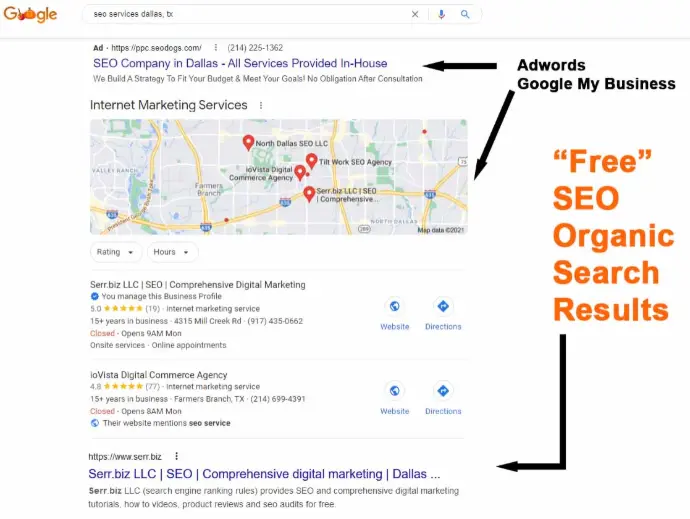
SEO Note:
In addition to a formal website, the number one thing a local business must do for “seo” is create a Google My Business profile. This is the profile which is seen in Google Maps, and is often seen BEFORE “organic” search results. There are additional “seo” tactics specific to Google My Business pages, but that is a different tutorial.
Google Marketing Tip:
The fastest way into Google is simply to pay for advertisements using Google Adwords. That can be costly and when you stop paying, you stop having visibility in the search engines. Every good marketer incorporates SEO and PAID advertising aka SEM / PPC.
Part 2: Three concepts - Code, Content, Backlinks - CCB
Now that we have a general understanding of what SEO is and isn’t let’s explore the the three primary areas of optimization, which we call CCB: Code, Content and Backlinks
Let’s unpack CCB starting with CODE.
What is CODE in SEO?
For the purpose of this tutorial we are going to refer to “code” in very broad and general terms. Code means all the hidden things a visitor to your website never sees. That’s HTML, CSS, JS, Meta tags, Schema, Etc. It also includes hosting configuration, domain name, DNS, etc. In short, code get’s complicated, technical and most local business owners do NOT need to know 99% of code. In fact, we do NOT recommend that local business owners spend much time on the more technical aspects of SEO CODE. A little bit of knowledge can be dangerous. However, what a local business owner does need to know related to code is the following.
Is your website mobile friendly and responsive?
This means does it load quickly on your phone and can people easily navigate it. Google now tests for "mobility".
Is it FAST?
Google does look at your website for speed and mobility. More importantly, so do users. If your website loads slowly, then humans will likely go away. A properly optimized website should “load” in less than 3 seconds. Usability does factor into SEO.
Do you have HTTPS?
If you can visit your website without adding an S to HTTP, then it is NOT fully secure. If you do not have HTTPS, you need to get an SSL. All requests to the http version of your website should auto-redirect to the https version. Google chrome uses will often get a “WARNING” notice if a site is not secure. When users see this, they will go away.
Part 3: What are title, meta description and keywords tags
Do you have optimized “title” tags?
What’s a title tag? The title tag is a bit of text that is seen in the browser and it is the “link” seen in Google search results. There should be an option within your website to add a title tag.
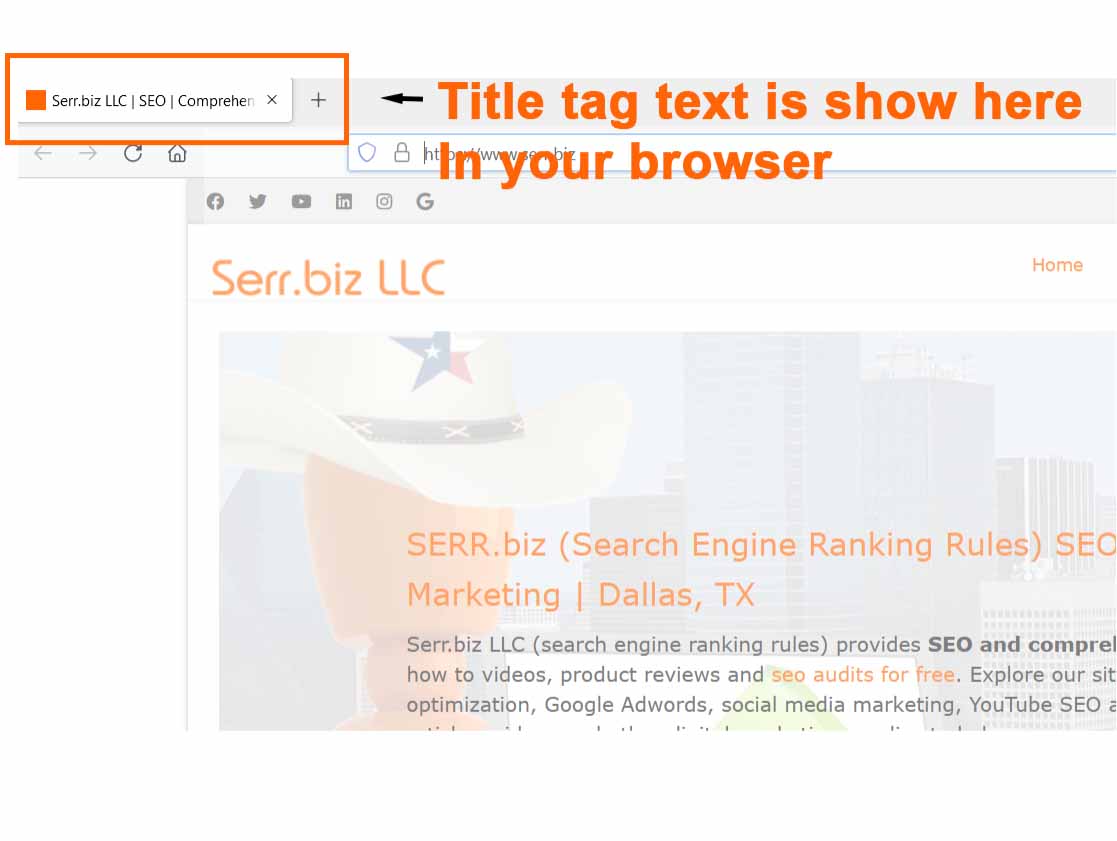
Do you have a meta description?
A meta description is a short description of your website that is seen in the search results. This no longer has relevance for direct SEO, but a good META Description can increase the number of clicks you get when your site is seen in search results. That is called click-thru rate (CTR). CTR is a factor in SEO.
Keyword tags - WARNING DO NOT USE!!!
In the hidden parts of a website there is often a function to add “keywords” to a web page. This specifically populates an old meta tag called “keywords”. This function was abused so severely by web masters and “seo experts” that if used now, it is a great big SPAM RED FLAG. Do NOT use it if it exists in your system. We only mention so you don’t accidentally use it and hurt your site.
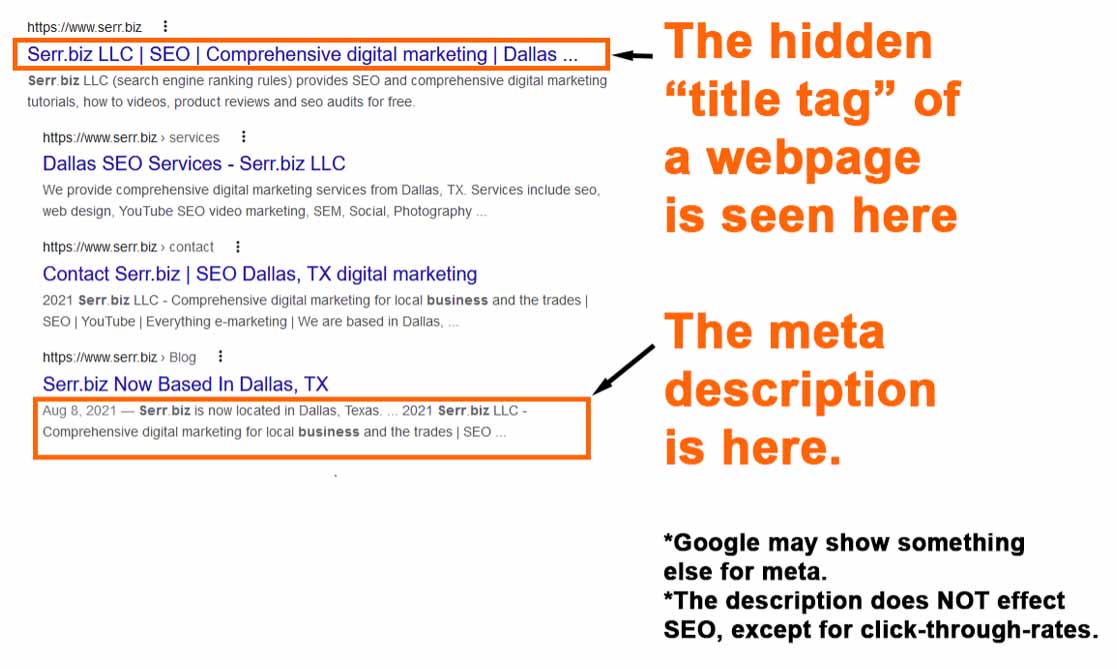
Part 4: Header tags H1, H2, H3
Do all the pages of your website have H1, H2, and h3 tags, at least?
“H” tags are heading tags. Depending on your site code, “H” tags make your text larger. They are headings after all. Headings are like headlines in a newspaper or magazine article. They help readers, and Google, know what the important ideas are on an individual page of your website. This is important for small local business owners to know about when writing and adding the content to their website. Most “website builder” software aka content management systems (CMS), have a place for the admin to add and format their content with H tags as appropriate.
*DO NOT ABUSE HEADER TAGS
SEO Note: Only use H1 and H2 tags once per page if possible. Use H3 as many times as needed. Use h4 and h5 for the “footer” area of your pages such as your location and privacy info headers.
Part 5: ALT Tags
Do all of your images have ALT tags?
An ALT tag is a little bit of code added to each image of your website which describes what the content of the image is. This helps Google, but more importantly it helps the visually challenged use your site. All good CMS systems let you add ALT tags to your images. Technically, ALT tags do NOT help directly with SEO, but they do make the page more “usable”. Usability does effect SEO.
Part 6: What are search engine friendly URLS (aka SEFS)?
Does your site use SEF (search engine friendly) URLS?
SEF urls are also called HUMAN FRIENDLY urls. Can a human look at the full url of your of page and read it? Or, does it look something like this:
https://www.mydomain.com/index.php?id=568&l=1&txy=qr .
If it looks like that it is not search engine or human friendly. SEF urls help search engines and humans read and understand what your page is about. An SEF looks like this:
https://www.mydomain.com/services
SEO Note: All good CMS platforms allow for SEF urls and the admin has the option of custom creating the SEF.
Part 7: Schema mark up
Does your site use microformats, schema and/or open graph?
Now, this is pretty technical, but newer CMS systems allow small business admins to add their own Schema and/or the CMS adds the code automatically. It’s important to understand what they are because the search engines REALLY, REALLY, REALLY like them. In short, they are additional hidden code added to the content to each page which are specifically designed to help search engines and social media sites understand what your website is about. We will delve into this more later.
Part 8: XML Sitemaps
Does your site have an XML site map?
Typically, a good CMS has this function and it is auto generated. An XML site map uses the XML mark up to create list of all public URLS of your website. The primary purpose of having an XML site map is to give it to Google once your site is built. This will help Google find and index your site. All good CMS systems will auto-generate an XML site map for you. To see if you have one pull up this page in your website.
https://www.mysite.com/sitemap.xml
If nothing shows up, you probably don’t have one.
*Once we’ve optimized a site, we’ll show you how to add your XML site map to Google.
*It’s also helpful to have an HTML version of the site map, but it is not required for SEO. It can also be cumbersome to maintain if your site does not auto generate it.
Summary of SEO CODE.
The above are the most important aspects of SEO code a small business owner should know whether they are DIY or hiring an expert. There are more, but when building your website or switching to a new platform, you want to ask about the “code” above.
Now, let’s explore the second C of CCB: Content
Part 9: What is SEO Content
SEO content, as it relates to the local small business owner, is all the text, images, video and downloads (PDF, MP3, Etc) you add to your website. This includes your articles, products, services, reviews, about us, etc. What is most important about “seo content” is that it MUST be UNIQUE to your business and it MUST be “readable” by the search engines as well as people.
There is a popular saying in SEO..
CONTENT IS KING!
(But, it must be readable by the search engines and humans)
And, that is 100% true, but it has to be unique and the search engines must be able to find and read it. We call that RUC - Readable Unique Content.
Additionally, it must be FORMATTED correctly. That is where SEO CODE comes into play. Primarily the use of header tags, alt tags, titles, etc.
Ideally, new SEO content should be added to local business website at least once a week. At the least, once a month. If you can’t add new content once a month, you may have difficulty getting to the top of the search engines and staying there.
If your business time constraints do not allow you to create new content at least once a month, we strongly encourage you to find an expert to help.
SEO Content Summary
In short, SEO content must be added at least monthly, be unique to your business and properly formatted with SEO code.
Part 10: What are backlinks?
B stands for BACKLINKS.
A backlink is when a 3rd party website links back to you. Why is this important? The short answer is a backlink is like a “vote”. When a 3rd party website has a link to your website, it is like they are voting for you. What differs in SEO is not all votes count, not all votes are equal, and not all votes are good. First, let’s talk about good votes / good backlinks.
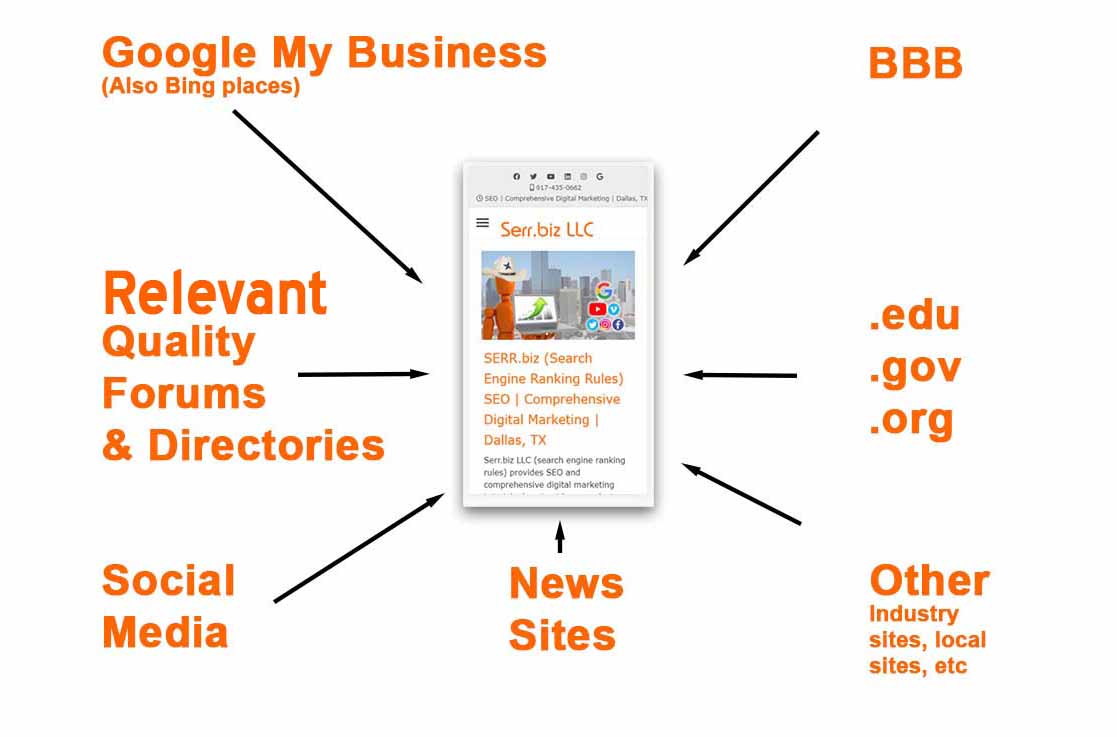
What is a good backlink?
Google, and other search engines, use backlinks as a way to find, qualify and validate your website. If a large authority website that Google likes links to you, then you get a little more credibility within your niche. The more relevant and quality sites link to you, the more your credibility and relevance goes up, as does your ranking in the search engines.
One of the easiest and important backlinks you can get is from Google themselves. How? Once you have a website ready for public viewing, create a Google My Business (Google Map Listing) and be sure to add your domain in the WEBSITE field. Then, take the time to VALIDATE your GMB profile. You validate your listing by entering a code Google sent via post card. When you enter the code from the post card sent to your related business address, your GMB is “validated”. The real world act of validating your listing instantly validates the link from your GMB profile to your website. For local business owners this is a 100% MUST DO.
After creating a GMB, be sure to then create additional back links by creating business profiles in the major social media sites. Small business owners should have profiles in the following social media platforms: YouTube, Facebook, Instagram, LinkedIn. Twitter is also good, but the top 4 plus GMB are enough for a small business to keep up with. Of course, there may be others more relevant based on your business. For example a home decore company should invest time in a Pinterest profile over a Twitter profile. A sporting goods store might prioritize Twitter over a Pinterest. A computer store might prioritize Reddit over Instagram. When choosing which social media platforms to have, ask yourself this.
“Do my customers use this social media platform?”
SEO Note
Backlinks from social sites do not count the same as links from authority sites like a .edu or .gov sites, however they do increase citations, brand awareness and can lead to a true authority sites linking to you. Ultimately, you need HUMANS to visit your local business website and make a purchase, not Google. Always keep that in mind.
What is a BAD backlink?
Unlike voting in a real world election, you can get “bad” votes, bad backlinks. For example. If you sell shoes, and some random farming website links you, this could negatively effect you. Additionally, there are many bad actors promising 1000’s of backlinks quickly. Avoid those like the plague.
SEO Backlink summary
A “good” backlink is when a relevant and authoritative 3rd party website links back to your website.
Part 11: Choosing an SEO enabled website builder and WHY
What is Duda.co ?
Duda is a very good hosted content management system (CMS) which produces very good SEO results for local businesses. As the website owner, you do not have to worry about updates or coding. The CMS is clean, relatively intuitive and easy to use. Even the basic package website comes with ssl, mobile friendly templates, forms, SEF, schema options, open graph and a XML site map. The only thing local business owners need to do is add their SEO content.
*2024 UPDATE: If you want more than a website/ecommerce such as POS, warehousing, HR, project management, CRM, explore Odoo >>
Besides Duda what other SEO Web Builders and CMS are there?
Though there are many Website Builders / CMS systems available such as Joomla, Wix, Godaddy, Shopify, etc, the most popular is Wordpress (WP). However, we don’t actually recommend WP or any of the others, for small business owners, unless you have an expert to help you. To use WordPress successfully, and others, you need to add a variety of plugins to make them perfectly SEO and additional plugins for forms, schema, etc. WordPress itself has frequent updates. All the plugins used also have to be updated. Wordpress updates often lead to broken sites. Failing to keep your WP site updated, or other platforms, can lead to hacks. Both are bad for your SEO and BUSINESS. In our experience, local business owners do not have the time or expertise to keep the site updated and functioning properly.
So, for this tutorial, we will use Duda.co (Yes, .CO not .COM).
Before we get started with Duda and implementing CCB for our SEO, let’s gather our prime keywords.
Part 12: Choosing a SEO keywords
Every business needs to know what keywords they should optimize for. Choosing the right keywords will help Google and Humans find you. In our example, we are going to optimize a martial arts school in Dallas TX (TKA Dojo). There are many paid services and keyword research tools available to identify the prime keywords. However, we recommend you start with Google. Visit Google, search a phrase you think is important and relevant to your customers. As you do, Google makes suggestions. Google makes those suggestions based on what people have searched in the past and are currently popular. If you are optimizing primarily for Google, it's a good idea to trust what Google says are the most popular search phrases and keywords.
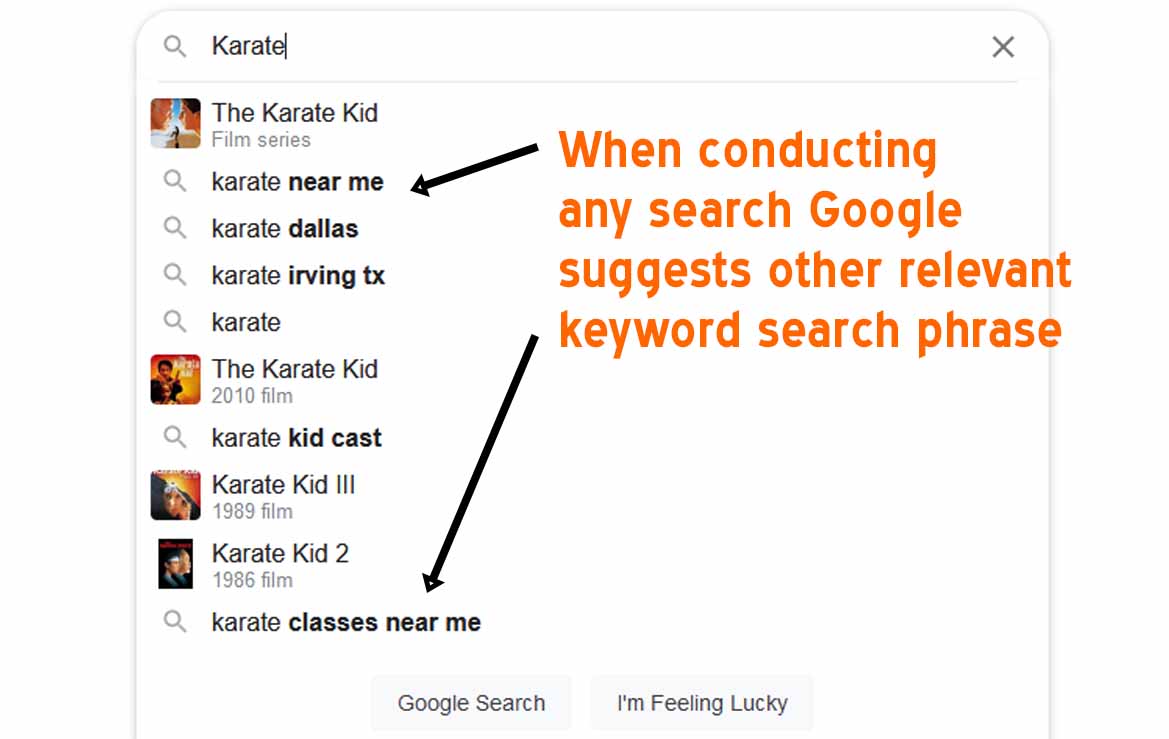
Choose one, and then scroll to the bottom of the Google search result page. At the bottom of the page, there are additional related searches.
Copy and paste those search phrases into a Google spreadsheet or other document you can refer back to.
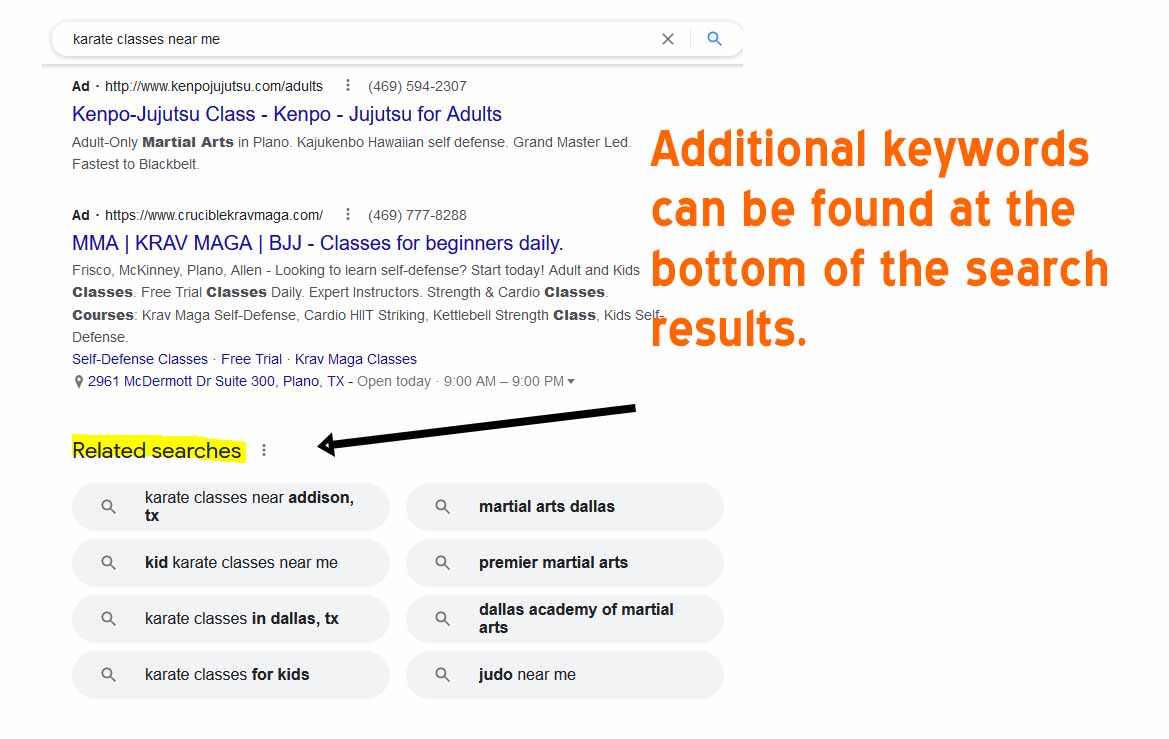
Additionally, check Google Trends. It is free and will tell you what words and phrases are popular and “trending”. Be sure to use synonyms when compiling your lists.
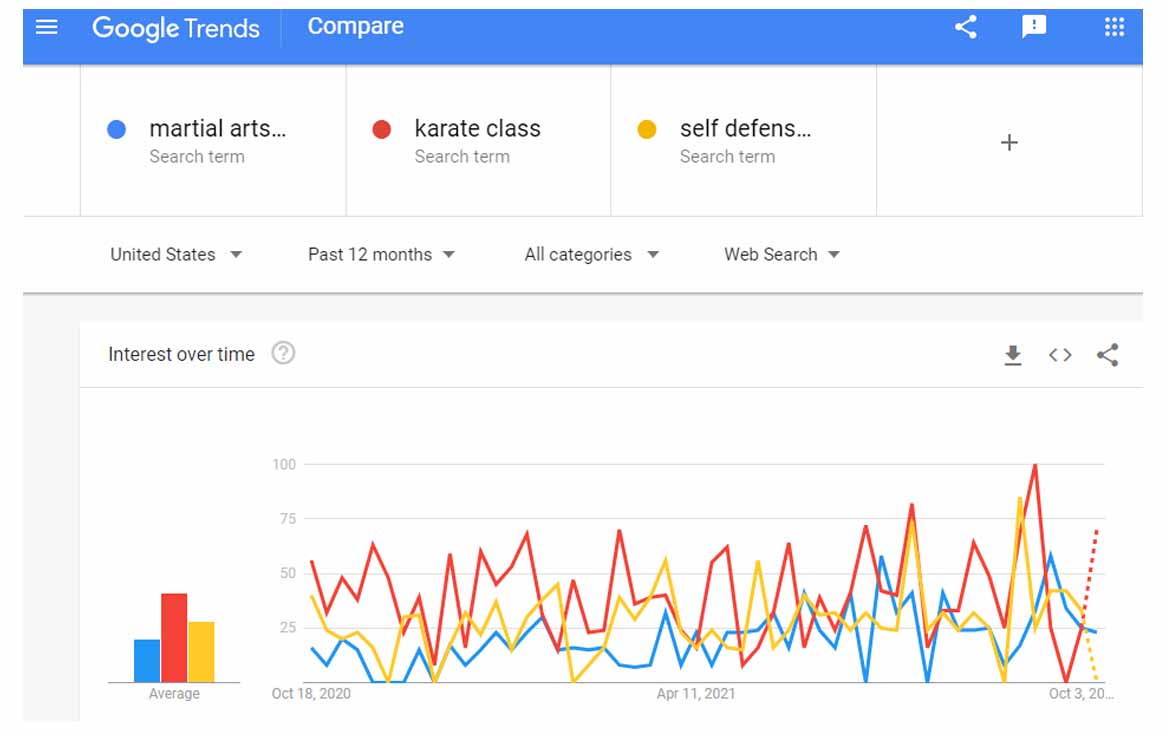
Using Adwords to choose keywords
If you have a Google Adwords account, you can get even more information about keywords. We do, so we are going to include that data set to help us make decisions.
Tip: When using Google Adwords to research keywords, there is an option to set region. We strongly encourage this. Use the "region" function often show different results.
Note: As a local business owner, you really should have a Google Adwords account. It's free to set up and you'll also be able to use it to promote your business and see instant results. *You have to be a paid advertiser to see detailed search volume.
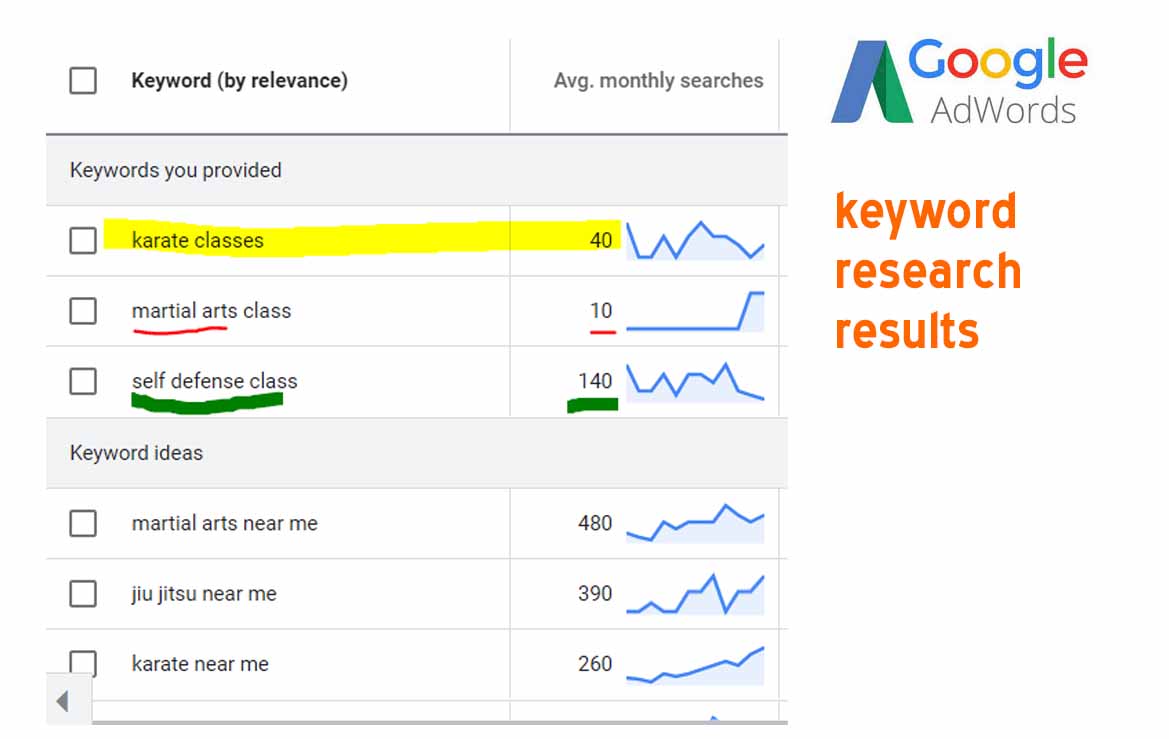
The above shows that SELF DEFENSE class is the most popular term, while Martial Arts Class, is the lowest searched term. However, “martial arts near me” is the most popular related term. Though some people include “near me” in their titles and descriptions, we prefer to use GEO specific terms, schema markup (which we will discuss later) and Google Maps to help Google know if a website is “near me”.
Another way to know which keywords are most relevant, is to look at the actual search results in Google. In this example we learn a few things. We searched “karate class Dallas”.
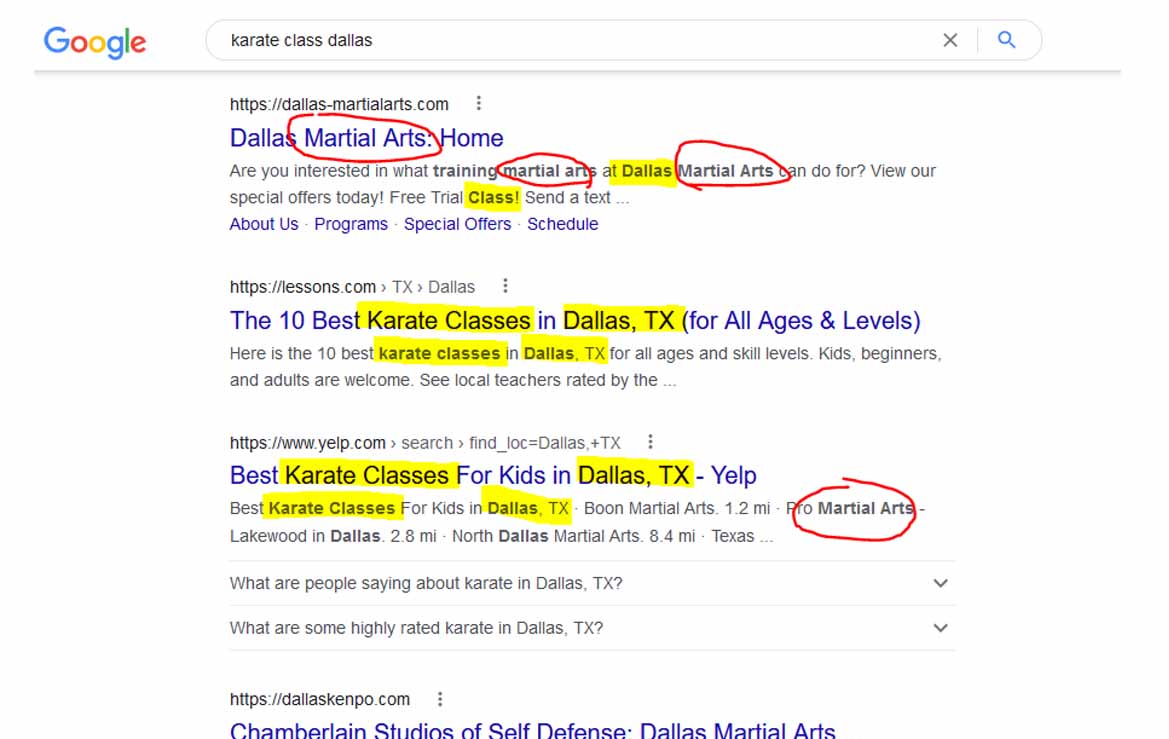
We learned the number one site for the search phrase “Karate Class Dallas” actually optimized for “Dallas Martial Arts : Home”. Technically, that is not great “seo”. They are probably number one for the following reasons:
- The site in question launched in 2011.
- Has a good quality backlinks (188 from 48 domains)
- Has a ton of reviews (33 five star in Google Maps)
- Their domain name includes the words “martial arts” and “Dallas”. (Dallas-martialarts.com).
- They did optimize for “martial arts” which is a synonym for karate.
- The did optimize for the geo specific term: Dallas
That is VERY curious as it is a poorly optimized title according to standard best practices of SEO. It shows that Google understands synonyms. What it also tells us, and this is IMPORTANT, that Google considers “Martial Arts” a very important phrase. It should be included if possible in the home page title and description. However, the next top site does include “karate classes” in the title as do number 3 and number 5. However, the 2nd site does NOT reference martial arts in the title or meta description.
- We learned that our competitors used the plural form “classes” in their titles. No one used the singular “class”.
- We learned that our competitors who included geo keywords used “Dallas, TX” vs “Dallas Texas”.
- We learned that almost all of the top sites shown use “martial arts”, “karate”, “Classes” and “Dallas, TX in their descriptions.
Given the above, we have discovered that our primary keywords are: Martial arts, Karate, Classes, Dallas TX. We will be using these terms through out the the website. Now, let's write a HTML title and description for our home page.
SEO Notes:
This process of choosing keywords should be applied to EVERY public page of your website. Whether it is a service page, product page, contact page, blog post, etc., if Google can find it, then time and consideration should be used to choose the right keywords.
When creating content, it is often advisable to choose some target keywords BEFORE you create. Knowing the keywords your are striving to get exposure and traffic for will influence the content you make.
In all your decisions about what keywords to choose, remember you have two audiences: Google Bot and HUMANS.
Choosing keywords is half ART half SCIENCE.
Part 13: Writing HTML titles and meta descriptions
Given SEO is literally a game of “follow the leader”, and based on the keyword research above, we decided to make the home page title and meta as follows.
Take Karate classes in Dallas, TX | Martial Arts | TKA Dojo
Want to learn traditional martial arts? Take Karate classes in Dallas, TX. First class free! Call 469-277-0726 to schedule a self defense lesson. Dojo in Plano too!
You can see we included Karate classes, Dallas TX, Martial Arts and the brand name. Some might say leading with “take” and including the brand name is not optimal. Our thinking is this.
We are optimizing for Google and HUMANS. Google factors CLICK-THOUGH -RATES (CTR) into your ranking. So, turning our title into a call to action by leading with “take” we strive to increase CTR.
We included TKA Dojo for two reasons. Using our brand name shows Google and Humans we are interested in building our brand, not just SEO. The word Dojo is semantically related to Karate and Martial arts. Using semantically related phrases is useful for SEO. Also the use of dojo sets a tone of “traditionalism” for the human who will ultimately take the class. TKA Dojo teaches traditional Shotokan Karate. Students wear traditional clothing, bow, etc.
SEO Notes: Though SEO is a game of follow the leader, it does not always mean the very number one site. In this case, we consider the top 5 sites the leaders, and made decisions based on the top results, not just the number one site. We also balanced the keywords with what the website’s exact services are. TKA Dojo provides classes in traditional martial arts Karate and Aikido, which is also self defense. We will optimize a different page for Aikido as we know it has less search volume than the more generic terms.
Though the number one site is not overly optimized, it is probably benefiting from longevity, quality backlinks, reviews and the ever evolving Google Knowledge Graph. Google Knowledge Graph is highly technical, and outside the scope of this tutorial. What is important to know is broad match synonyms can and should be used for SEO purposes.
The reason we STARTED with keyword research and the meta description is so we don’t have to correct it later. Now that we know what our keyword and related title / description are we will be better able to create a page to support our SEO goal. Of course, you will have to balance your SEO goal with your actual products / service offering and what language works best for converting visitors to customers.
Title text should be between 10-70 characters
Meta descriptions should be between 160-300 characters long.
Part 14: Optimizing Title and Meta Description Of Interior Pages
Given SEO is literally a game of “follow the leader”, and based on the keyword research above, we decided to make the home page title and meta as follows.
Take Karate classes in Dallas, TX | Martial Arts | TKA Dojo
Want to learn traditional martial arts? Take Karate classes in Dallas, TX. First class free! Call 469-277-0726 to schedule a self defense lesson. Dojo in Plano too!
You can see we included Karate classes, Dallas TX, Martial Arts and the brand name. Some might say leading with “take” and including the brand name is not optimal. Our thinking is this.
We are optimizing for Google and HUMANS. Google factors CLICK-THOUGH -RATES (CTR) into your ranking. So, turning our title into a call to action by leading with “take” we strive to increase CTR.
We included TKA Dojo for two reasons. Using our brand name shows Google and Humans we are interested in building our brand, not just SEO. The word Dojo is semantically related to Karate and Martial arts. Using semantically related phrases is useful for SEO. Also the use of dojo sets a tone of “traditionalism” for the human who will ultimately take the class. TKA Dojo teaches traditional Shotokan Karate. Students wear traditional clothing, bow, etc.
SEO Notes: Though SEO is a game of follow the leader, it does not always mean the very number one site. In this case, we consider the top 5 sites the leaders, and made decisions based on the top results, not just the number one site. We also balanced the keywords with what the website’s exact services are. TKA Dojo provides classes in traditional martial arts Karate and Aikido, which is also self defense. We will optimize a different page for Aikido as we know it has less search volume than the more generic terms.
Though the number one site is not overly optimized, it is probably benefiting from longevity, quality backlinks, reviews and the ever evolving Google Knowledge Graph. Google Knowledge Graph is highly technical, and outside the scope of this tutorial. What is important to know is broad match synonyms can and should be used for SEO purposes.
The reason we STARTED with keyword research and the meta description is so we don’t have to correct it later. Now that we know what our keyword and related title / description are we will be better able to create a page to support our SEO goal. Of course, you will have to balance your SEO goal with your actual products / service offering and what language works best for converting visitors to customers.
Title text should be between 10-70 characters
Meta descriptions should be between 160-300 characters long.
Part 15: Use header tags - H1, H2, H3 examples in Duda, Wordpress and Joomla
Google and other search engines LIKE when a web designer uses H1, H2, H3 tags in their website. As we mentioned earlier, header tags are like newspaper “headlines” and should be constructed as short summaries of the text that follows. Though header tags and “keyword density” have lost some SEO juice over the years, we find they are still at play in local sites. You do not need to obsess, but the natural use of header tags with some targeted keywords should be used.
Additionally, we found that you should only use the H1 tag once. The same applies to the h2 tag. H3 and smaller can be used as desired.
In the case of TKA Dojo our h1 and h2 tags will be as follows.
H1: Martial Arts Karate Classes, Aikido & Self Defense Dallas, TX
H2: Traditional Martial Arts Class
We find that when writing your h1 and h2 tags, it’s important that they are interchangeable from a human readability level.
For example, let’s take the first part of the H1 tag and the first part of theH2 tag and we come up with “Learn traditional self defense”. That is a human readable sentence. If we use the ending we get “ Karate Classes Dallas, TX”.
SEO Web Design Note: Typically, by default, header tags change the size of the lettering of the words applied to. Through CSS, and most page editors, it is easy to control the visual presentation of header tags. Personally, I like to see larger bold fonts with well written headlines. It helps me scan a page for the content I’m most interested in. However, if you are striving for a particular design aesthetic, you do have design options, but can still be SEO.
In the lower levels of the page we will use the following h3 tags:
- Our Kids Karate Classes
- Karate for Tween-Teens
- Adult Aikido Classes
- karate class reviews and others.
We will also include some non keyword targets, but related terms like “dojo, schedule, sensei” etc. Additionally, Google is making great strides to read, understand your website like a human does, not a robot.
In addition to header tags we made sure to include keywords in our supporting text, especially under our H1 tag. The supporting text also includes the use of BOLD on key and related terms. Take a look.

Part 16: Use ALT tags on images
An alt tag is hidden bit of code which allows for a written description of the image. In Duda and other CMS systems, it’s usually pretty easy to add an alt tag to your images. Some CMS also include a “tool tip”. In our case, we used both ALT Tags and tool tips. The purpose of alt tag is to help the visually challenged use a text reader to understand what an image is about. Even if you don’t think a visually challenged person would use your services remember Google is a visually challenged bot who really, really, really appreciates all the help you can give them in understanding your page content.
Part 17: Navigation and linking - Hub and Spoke Strategy >>
We referenced “content hubs” above. When just getting started the “hub” pages are going to be your primary service pages. You’ll create blog posts and other sub pages with related content linking back to your “services” page. The blog posts can be thought of as “spokes” of the hub.
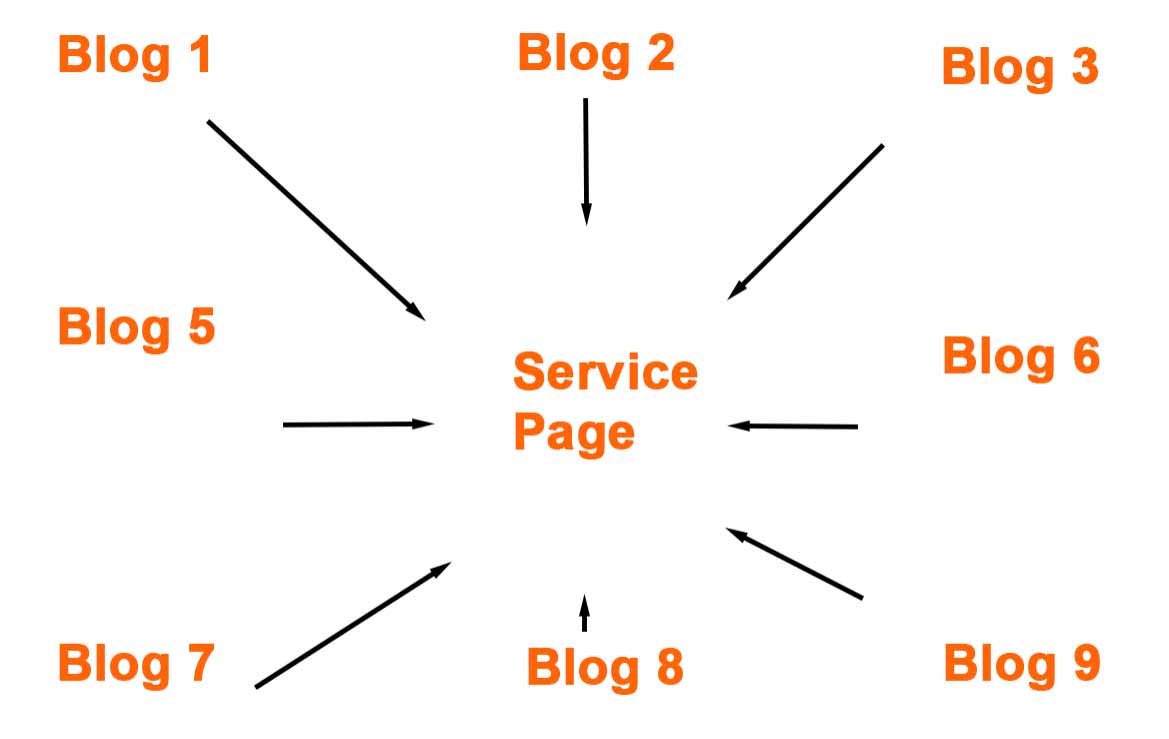
It’s important to reference your keyword research and balance your interior pages with SEO objectives. Then, as your site grows, and it should always be growing, you can create more “hubs” with supporting blog posts.
SEO Note: When creating blog posts be sure to choose a relevant keyword or phrase within the body copy and turn it into a link pointing back to the HUB page.
In the case of TKA Dojo, we chose 2 primary phrases to make top level pages which are included in the global navigation. They are: Karate Classes and Martial Arts Training. We could have simply called them Classes and Training, but that was not as “seo” as targeting “Karate Classes” and “Martial Arts Training”.
Additionally, in the Duda system, our page names are converted into search engine friendly urls.
SEO NOTE:
Search engine friendly URLS play an important role in your SEO. In our case, one of our core keyword targets is “karate classes”. In the three examples below which one do you think Google and humans will like the most?
- tkadojo.com/classes
- tkadojo.com/karate-classes
- tkadojo.com/index.php?id=5
Obviously, /karate-classes is the most informative.
Duda SEO note:
By default, Duda uses a dash in the SEF. Underscores are also valid, but we like dashes better. Under_scores can sometimes be visually hard to see and a user trying to recall your url might type in /karate classes, which would result in a 404 error. Google is not a fan of 404 pages and humans definitely don’t like error pages.
More SEO notes about links and keywords.
In the examples below we deliberately added links in the global header to the two locations in question and in the footer. We did so because Google gives more weight to text that is a link vs text that is not. We also did it for humans. By adding those links at the top of the page it will help humans know where we are located.

In the header we linked to the contact page which has the address of both locations as well as maps.
In the footer we did NOT link the exact phrase. Instead, we used h6 tags for the exact keywords and then linked the addresses to their respective GMB pages. Though linking off your page can cause “link bleed”, the address links lead to branded and official pages about your site. It is also a Google property which has been verified. Linking to your Google GMB further tells Google you are a real business providing a real service. Also, the GMB page links back to the website. So, the link bleed also comes back as good “link juice”. The “vote in” from your GMB page, when first starting out, has a higher value than the link out.
SEO Warning:
Do NOT abuse SEF urls. Try to keep them short and on topic. If you want to hit more keywords, make more pages.
FAQ content, Schema and more Schema.
On the home page, we lead with FAQS for a number of reasons.
- To help user learn more about TKA Dojo
- Duda has a built in function to add “schema” markup to the FAQS you create
- Google loves FAQ Schema and often uses it to add “site links” in the search results
Part 18: Local business Schema.
As we mentioned way back in the beginning of this tutorial, Schema is hidden code that helps Google and other search engines know what your website is about.
For local owners the top 3 schema markups you want to add to your website are:
- Local business
- Reviews
- One of the following based on your business: Events, products or services.
You can add others, but those are the top Schema to focus on when starting
In the case of TKA Dojo, we chose events. Part of their marketing strategy is to offer FREE classes. These occur multiple times per week. A class is an event. *We could have chosen Schema mark up for a “course” but events are more common and popular. We also add the events to our GMB, so that was another reason we chose to create schema events.
Schema mark up gets very geeky and is probably out of the scope of most local business owners to implement correctly. Proper implementation of schema is VERY important. Bad implementation can lead to BAD SEO results. However, that is why we recommend Duda. Duda has the FAQ schema built in, but also has an upgrade plan for adding advanced schema such as local business tags, etc.
If you are starting out with Duda, you can use this FREE tool to generate LOCAL SCHEMA.
https://technicalseo.com/tools/schema-markup-generator/
SEO Note: One the rules of using schema markup is to only add schema that relates to the page. If you remember, we added our local business address to the footer of EVERY page of the website. So, we added the local business schema to every page.
Part 19: Finding Relevant Backlinks
If we recall from CCB, the B stood for backlinks. Backlinks are a super important aspect of SEO. In fact, there are companies that specialize in just backlinks. There are a lot of spammy services for that as well. We avoid most of them like the pariahs that they are. One of the easiest ways to relevant backlinks is to conduct an backlink audit of your competitors in Google. Just search your competitors name / domain name in quotes. Depending on your industry, Google will often show many sites where your competitors name is mentioned. Visit the site and see what it is about. If it looks like an important or relevant site check and see if you can add a profile or get a link. Often, competitors wind up in popular "top ten" lists of community websites. Just by asking, it is often possible to get listed. Now, let's watch the next video to see how it is done.
Best Backlink Service Provider - Yext
However, the one provider we like is Yext. It is a paid service that helps you list your site in relevant and valid directories and yellow pages. For the cost, you can’t beat it. For more information about Yext and optimizing check out our Yext tutorial. What is most important about Yext is that you use the same Name, Phone, Address (NAP) and Website you used in your Google My Business page.
This also applies to your social, when possible.
Social Media Profiles and SEO
Social business pages are excellent for creating backlinks. As we mentioned before, social profiles and subsequent backlinks do not technically “count” as a vote. However, they do count as a citation and a further verification of your brand. Adding links in social media will help others find your site and content, and if they like it, they may well link to it from a legitimate, authority website.
Additionally, we do know Google does use social media to FIND your site. They may not count the vote, but the more the Google Bot finds you, assuming you have good quality content, the better.
SEO Debate:
Even though the general consensus is Google does not count backlinks from social, we have seen some social backlinks surfaced in Google Search Console. We have seen YouTube, Pinterest Flickr and Reddit backlinks shown in GSC. Is google ‘counting” the vote or just showing you that there is a link? That is up for debate.
Additional valid backlinks for local business owners
If you belong to any organizations such as charity, professional organizations, etc, ask each and everyone to link to you from their website. Those are valid sources. Other sources are local newspapers (the digital versions at least), trade magazines, The BBB of course, etc.
More ways to find backlinks.
There are additional ways to find relevant backlinks. Ahrefs.com is a great tool for that. Start with your top competitors and check THEIR back links. Then, try to get a link from the same sources if relevant.
Part 20: Getting into Google
Getting Into Google
Now that we have an optimized website with basic CCB via Duda, there are 2 more things to do.
Set up a Google Analytics account and add the code to your website.
What is Google Analytics? GA, for short, is a tracking tool which will give you valuable insight to how people find you, what they do while on your site, where they came from and a ton of other goodies. GA doesn’t effect SEO, but it can help you make good SEO choices.
Sign up for Google Analytics here >>
*Though Google has explicitly said they do not use GA data to determine relevance in search results, my opinion is why wouldn’t they? Personal opinion aside, GA is great at helping you make SEO decisions.
Set up a Google Search Console profile.
This is super important. Here is the basic process in the video below. This is where your XML site map comes into play. Note, you can also submit your XML site map to Bing. DuckDuckGo does not have a sitemap option. They will find you on their own.
Create a Google Search Console profile here >>
Part 21: The END.. Sort of..
As a local business owner, if you’ve read this tutorial, optimized all of the pages on your website, submitted to Google Search Console and created a GMB, your basic SEO is done.
You are now prepared to continue making more SEO content and growing your brand and business online and off.
We strongly recommend that you commit to making new content on a weekly basis, at the very least, monthly.
If you've determined you would like professional assistance with your local search engine optimization, contact us for a free quote >>